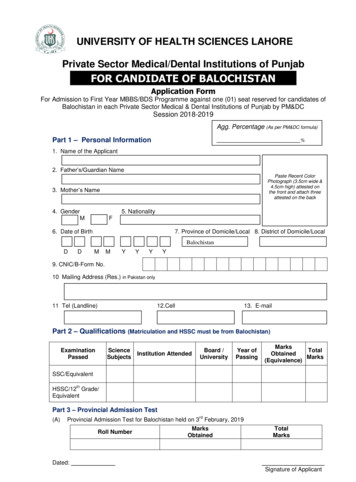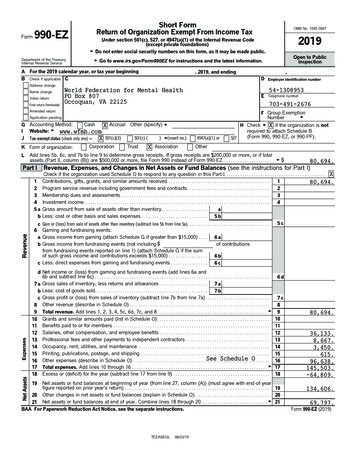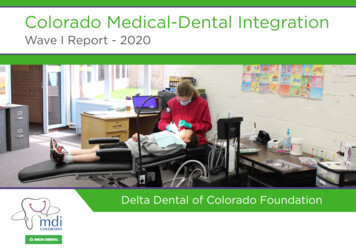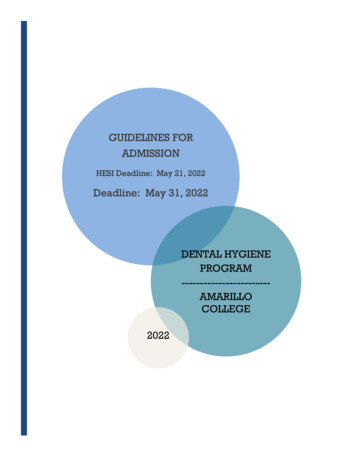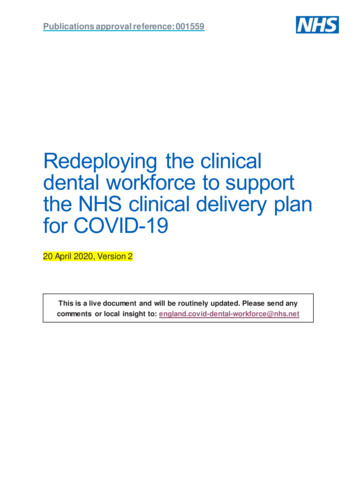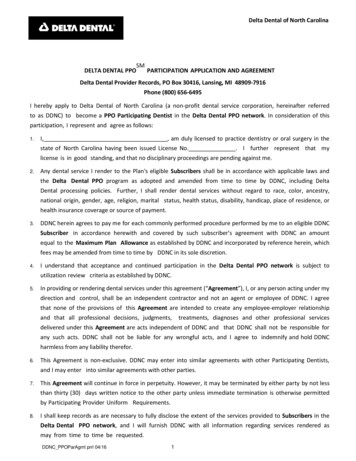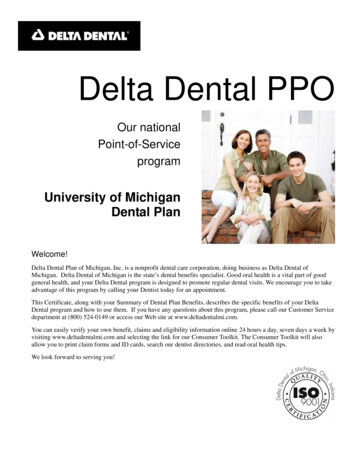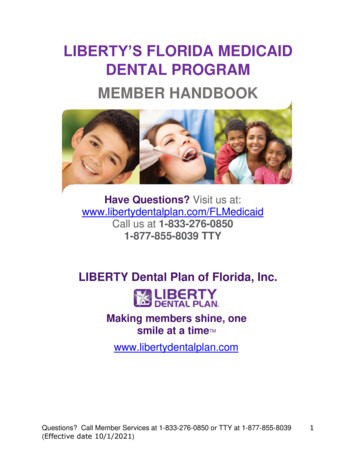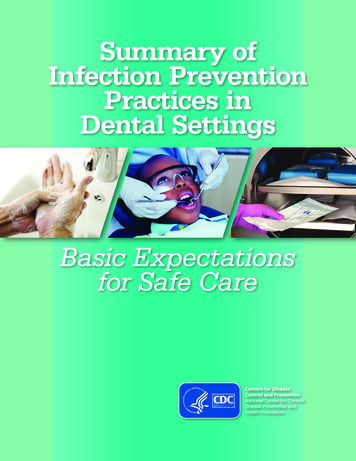
Transcription
CONFIDENTIALMedical Dental History Formfor Patients Under Age 18PatientDatePatient’s last nameFirst namePrefers to be calledHobbies, activitiesBirth dateSexMaleFemaleMiddle initialSocial Security #School GradeEmail address(es)Home addressCity, State, Zip codeHome phone (Cell phone () -) -Parent/guardianCustodial parent(s) name(s)Patient lives with (check all that apply)MotherFatherStepmotherStepfatherFather’s full ail addressAddress (if different)Home phone (If different) () -Cell phone () -MrsMsDrWork phone () -Mother’s full nameTitle:OtherOccupationEmail addressAddress (if different)Home Phone (If different) () -Cell phone () -Work phone () -DentistPatient’s DentistAddress, City, StateLast seenReasonNext appointmentOther dentists/dental specialists now being seen: Name City, StateReasonGeneral InformationWhat concerns you about your child’s teeth?What concerns your child about his/her teeth?How does your child feel about orthodontic treatment?Who suggested that your child might need orthodontic treatment?Why did you select our office?Describe any previous orthodontic treatment or consultations.Does your child play a musical instrument?History Form – Child – 5/13
Brother/sister name agehad orthodontic treatment?YesNo If yes, where?Brother/sister name agehad orthodontic treatment?YesNo If yes, where?Brother/sister name agehad orthodontic treatment?YesNo If yes, where?Brother/sister name agehad orthodontic treatment?YesNo If yes, where?Have any other family members been treated in this office? Please name them.Financial ResponsibilityWho is financially responsible for this account?Address (if different than page 1)Home phone () -Cell phone (Social Security #City, State, Zip) -Email address(es)EmployerWho will be responsible for bringing the patient to orthodontic appointments?Dental InsurancePrimary policy holder’s full nameSocial Security #Birth dateRelationship to patientAddress and phone (if not listed above)EmployerAddressInsurance companyGroup #Does this policy have orthodontic benefits?YesNoID#Don’t KnowSecondary policy holder’s full nameSocial Security #Birth dateRelationship to patientAddress and phone (if not listed above)EmployerAddressInsurance companyGroup # ID#Does this policy have orthodontic benefits?YesNoDon’t KnowMedical InsurancePolicy holder’s full nameInsurance CompanyPhysicianPatient’s PhysicianCity, StateLast seenReasonNext appointmentMost recent physical examOther physicians/health care providers being seen now:NameCity, StateReasonNameCity, StateReasonHistory Form – Child – 5/13
Your answers are for office records only, and are confidential. A thorough medical history is essential to a complete orthodontic evaluation.For the following questions, please mark yes, no, or don’t know/understand (dk/u).Medical HistoryNow or in the past, has your child had:Has your child had allergies or reactions to any of the following?Yes No DK/U Local anesthetics (novocaine, lidocaine, xylocaine)Yes No DK/UBirth defects or hereditary problems? Latex (gloves, balloons)Bone fractures or major injuries? AspirinAny injuries to face, head, neck? Ibuprofen (Motrin, Advil)Arthritis or joint problems? PenicillinCancer, tumor, radiation treatment or chemotherapy? Other antibioticsEndocrine or thyroid problems? Metals (jewelry, clothing snaps)Diabetes or low sugar? AcrylicsKidney problems? Plant pollensImmune system problems? AnimalsHistory of osteoporosis? FoodsGonorrhea, syphilis, herpes, sexually transmitted diseases? Other substancesAIDS or HIV positive?Hepatitis, jaundice, or other liver problems?Polio, mononucleosis, tuberculosis, pneumonia?Seizures, fainting spells, neurologic problems?Dental HistoryNow or in the past, has your child had:Yes No DK/UMental health disturbance or depression?Erupting teeth very early or very late?History of eating disorder (anorexia, bulimia)?Primary (baby) teeth removed that were not loose?Frequent headaches or migraines?Permanent or extra (supernumerary) teeth removed?High or low blood pressure?Supernumerary (extra) or congenitally missing teeth?Excessive bleeding or bruising, anemia?Chipped or injured primary or permanent teeth?Chest pain, shortness of breath, tire easily, swollen ankles?Any sensitive or sore teeth?Heart defects, heart murmur, rheumatic heart disease? Any lost or broken fillings?Angina, arteriosclerosis, stroke or heart attack?Jaw fractures, cysts, infections?Skin disorder (other than common acne)?Any teeth treated with root canals or pulpotomies?Does your child eat a well-balanced diet?Frequent canker sores or cold sores?Vision, hearing, or speech problems?History of speech problems or speech therapy?Frequent ear infections, colds, throat infections?Difficulty breathing through nose?Asthma, sinus problems, hayfever?Mouth breathing habit or snoring at night?Tonsil or adenoid condition?History of speech problems?Does your child frequently breathe through his/her mouth?Frequent oral habits (sucking finger, chewing pen, etc)? Has your child ever taken intravenous bisphosphonatessuch as Zometa (zolendromic acid), Aredia (pamidronate)or Didronel (etidronate) for bone disorders or cancer? Has your child ever taken oral bisphosphonates such asFosamax (alendronate), Actonel(ridendronate), Boniva(ibandronate), Skelid (tiludronate) or Didronel (etidronate)for bone disorders?Teeth causing irritation to lip, cheek or gums?Tooth grinding or clenching?Clicking, locking in jaw joints?Soreness in jaw muscles or face muscles? Has your child been treated for “TMJ” or “TMD” problems?Any broken or missing fillings? Any serious trouble associated with previous dental treatment? Has your child ever been diagnosed with gum disease orpyorrhea?History Form – Child – 5/13
Patient Health InformationDo you think that any of your child’s activities affect his/her face, teeth or jaws? How?List any medication, nutritional supplements, herbal medications or non-prescription medicines, including fluoride supplements that your child takes.MedicationTaken forMedicationTaken forMedicationTaken forDoes your child take antibiotic pre-medication before any dental procedures?Does your child have (or ever had) a substance abuse problem?Does your child chew or smoke tobacco?Have you noticed any unusual changes in your child’s face or jaws?Any other physical problems?Family Medical HistoryHave the parents or siblings ever had any of the following health problems? If so, please explain.Bleeding disordersDiabetesArthritisSevere allergiesUnusual dental problemsJaw size imbalanceOther family medical conditions?How often does your child brush?Floss?Release and WaiverI authorize release of any information regarding my child’s orthodontic treatment to my dental and/or medical insurance company.Parent/Guardian SignatureDateI have read the above questions and understand them. I will not hold my orthodontist or any member of his/her staff responsible for any errorsor omissions that I have made in the completion of this form. I will notify my orthodontist of any changes in my child’s medical or dental health.Parent/Guardian SignatureDateMedical History Updates or ChangesChangesParent/Guardian SignatureDateDental Staff SignatureDateChangesParent/Guardian SignatureDateDental Staff SignatureDateChangesParent/Guardian SignatureDateDental Staff SignatureDate American Association of Orthodontists 2013History Form – Child – 5/13
InformedConsentfor the Orthodontic Patientrisks and Limitations of orthodontic treatmentSuccessful orthodontic treatment is a partnership betweenthe orthodontist and the patient. The doctor and staff arededicated to achieving the best possible result for eachpatient. As a general rule, informed and cooperative patientscan achieve positive orthodontic results. While recognizingthe benefits of a beautiful healthy smile, you should also beaware that, as with all healing arts, orthodontic treatmenthas limitations and potential risks. These are seldom seriousenough to indicate that you should not have treatment;however, all patients should seriously consider the option ofno orthodontic treatment at all by accepting their present oralcondition. Alternatives to orthodontic treatment vary withthe individual’s specific problem, and prosthetic solutions orlimited orthodontic treatment may be considerations. You areencouraged to discuss alternatives with the doctor prior tobeginning treatment.Orthodontics and Dentofacial Orthopedics is the dental specialty that includes the diagnosis,prevention, interception and correction of malocclusion, as well as neuromuscular and skeletalabnormalities of the developing or mature orofacial structures.An orthodontist is a dental specialist who has completed at least two additional years of graduatetraining in orthodontics at an accredited program after graduation from dental school.
Results of TreatmentOrthodontic treatment usually proceeds as planned,and we intend to do everything possible to achievethe best results for every patient. However, wecannot guarantee that you will be completely satisfied with your results, nor can all complicationsor consequences be anticipated. The success oftreatment depends on your cooperation in keepingappointments, maintaining good oral hygiene, avoiding loose or broken appliances, and following theorthodontist’s instructions carefully.Length of TreatmentThe length of treatment depends on a number ofissues, including the severity of the problem, thepatient’s growth and the level of patient cooperation.The actual treatment time is usually close to theestimated treatment time, but treatment may belengthened if, for example, unanticipated growthoccurs, if there are habits affecting the dentofacialstructures, if periodontal or other dental problemsoccur, or if patient cooperation is not adequate.Therefore, changes in the original treatment planmay become necessary. If treatment time is extended beyond the original estimate, additional fees maybe assessed.DiscomfortThe mouth is very sensitive so you can expect anadjustment period and some discomfort due tothe introduction of orthodontic appliances. Nonprescription pain medication can be used duringthis adjustment period.Please be aware that orthodontic treatment prior toorthognathic surgery often only aligns the teethwithin the individual dental arches. Therefore,patients discontinuing orthodontic treatment withoutcompleting the planned surgical procedures mayhave a malocclusion that is worse than when theybegan treatment!Decalcification and Dental CariesExcellent oral hygiene is essential during orthodontictreatment as are regular visits to your family dentist.Inadequate or improper hygiene could result incavities, discolored teeth, periodontal disease and/or decalcification. These same problems can occurwithout orthodontic treatment, but the risk is greaterto an individual wearing braces or other appliances.These problems may be aggravated if the patienthas not had the benefit of fluoridated water or itssubstitute, or if the patient consumes sweetenedbeverages or foods.Root ResorptionThe roots of some patients’ teeth become shorter(resorption) during orthodontic treatment. It is notknown exactly what causes root resorption, nor is itpossible to predict which patients will experience it.However, many patients have retained teeth throughout life with severely shortened roots. If resorptionis detected during orthodontic treatment, yourorthodontist may recommend a pause in treatmentor the removal of the appliances prior to the completion of orthodontic treatment.Nerve DamageRelapseCompleted orthodontic treatment does not guarantee perfectly straight teeth for the rest of your life.Retainers will be required to keep your teeth in theirnew positions as a result of your orthodontic treatment. You must wear your retainers as instructed orteeth may shift, in addition to other adverse effects.Regular retainer wear is often necessary for severalyears following orthodontic treatment. However,changes after that time can occur due to naturalcauses, including habits such as tongue thrusting,mouth breathing, and growth and maturation that continue throughout life. Later in life, most people willsee their teeth shift. Minor irregularities, particularlyin the lower front teeth, may have to be accepted.Some changes may require additional orthodontictreatment or, in some cases, surgery. Some situations may require non-removable retainers or otherdental appliances made by your family dentist.ExtractionsSome cases will require the removal of deciduous(baby) teeth or permanent teeth. There are additionalrisks associated with the removal of teeth whichyou should discuss with your family dentist or oralsurgeon prior to the procedure.Orthognathic SurgerySome patients have significant skeletal disharmonieswhich require orthodontic treatment in conjunctionwith orthognathic (dentofacial) surgery. There areadditional risks associated with this surgery whichyou should discuss with your oral and/or maxillofacial surgeon prior to beginning orthodontic treatment.A tooth that has been traumatized by an accident ordeep decay may have experienced damage to thenerve of the tooth. Orthodontic tooth movement may,in some cases, aggravate this condition. In somecases, root canal treatment may be necessary. Insevere cases, the tooth or teeth may be lost.Periodontal DiseasePeriodontal (gum and bone) disease can develop orworsen during orthodontic treatment due to manyfactors, but most often due to the lack of adequateoral hygiene. You must have your general dentist,or if indicated, a periodontist monitor your periodontal health during orthodontic treatment every threeto six months. If periodontal problems cannot becontrolled, orthodontic treatment may have to bediscontinued prior to completion.Injury From Orthodontic AppliancesActivities or foods which could damage, loosen ordislodge orthodontic appliances need to be avoided.Loosened or damaged orthodontic appliancescan be inhaled or swallowed or could cause otherdamage to the patient. You should inform yourorthodontist of any unusual symptoms or of anyloose or broken appliances as soon as they arenoticed. Damage to the enamel of a tooth or to arestoration (crown, bonding, veneer, etc.) is possiblewhen orthodontic appliances are removed. Thisproblem may be more likely when esthetic (clear ortooth colored) appliances have been selected. Ifdamage to a tooth or restoration occurs, restorationof the involved tooth/teeth by your dentist may benecessary.HeadgearsOrthodontic headgears can cause injury to the patient.Injuries can include damage to the face or eyes.In the event of injury or especially an eye injury,however minor, immediate medical help should besought. Refrain from wearing headgear in situationswhere there may be a chance that it could bedislodged or pulled off. Sports activities and gamesshould be avoided when wearing orthodonticheadgear.Temporomandibular (Jaw)Joint DysfunctionProblems may occur in the jaw joints, i.e., temporomandibular joints (TMJ), causing pain, headaches orear problems. Many factors can affect the health ofthe jaw joints, including past trauma (blows to thehead or face), arthritis, hereditary tendency to jawjoint problems, excessive tooth grinding or clenching,poorly balanced bite, and many medical conditions.Jaw joint problems may occur with or without orthodontic treatment. Any jaw joint symptoms, includingpain, jaw popping or difficulty opening or closing,should be promptly reported to the orthodontist.Treatment by other medical or dental specialistsmay be necessary.Impacted, Ankylosed,Unerupted TeethTeeth may become impacted (trapped below the boneor gums), ankylosed (fused to the bone) or just failto erupt. Oftentimes, these conditions occur for noapparent reason and generally cannot be anticipated.Treatment of these conditions depends on the particular circumstance and the overall importance of theinvolved tooth, and may require extraction, surgicalexposure, surgical transplantation or prostheticreplacement.Occlusal AdjustmentYou can expect minimal imperfections in the wayyour teeth meet following the end of treatment. Anocclusal equilibration procedure may be necessary,which is a grinding method used to fine-tune theocclusion. It may also be necessary to removea small amount of enamel in between the teeth,thereby “flattening” surfaces in order to reduce thepossibility of a relapse.Non-Ideal ResultsDue to the wide variation in the size and shape ofthe teeth, missing teeth, etc., achievement of anideal result (for example, complete closure of aspace) may not be possible. Restorative dentaltreatment, such as esthetic bonding, crowns orbridges or periodontal therapy, may be indicated.You are encouraged to ask your orthodontist andfamily dentist about adjunctive care.Third MolarsAs third molars (wisdom teeth) develop, your teethmay change alignment. Your dentist and/or orthodontist should monitor them in order to determinewhen and if the third molars need to be removed.Continued on next pagePatient or Parent/Guardian Initials
PatientDateAllergiesACKNOWLEDGEMENTCONSENT TO USE OF RECORDSOccasionally, patients can be allergic to some ofthe component materials of their orthodontic appliances. This may require a change in treatment planor discontinuance of treatment prior to completion.Although very uncommon, medical management ofdental material allergies may be necessary.I hereby acknowledge that I have read andfully understand the treatment considerations and risks presented in this form.I also understand that there may be otherproblems that occur less frequently thanthose presented, and that actual resultsmay differ from the anticipated results.I also acknowledge that I have discussedthis form with the undersigned orthodontist(s) and have been given the opportunityto ask any questions. I have been askedto make a choice about my treatment. Ihereby consent to the treatment proposedand authorize the orthodontist(s) indicatedbelow to provide the treatment. I alsoauthorize the orthodontist(s) to provide myhealth care information to my other healthcare providers. I understand that my treatment fee covers only treatment providedby the orthodontist(s), and that treatmentprovided by other dental or medical professionals is not included in the fee formy orthodontic treatment.I hereby give my permission for the use oforthodontic records, including photographs,made in the process of examinations,treatment, and retention for purposes ofprofessional consultations, research, education, or publication in professional journals.General Health ProblemsGeneral health problems such as bone, blood orendocrine disorders, and many prescription andnon-prescription drugs (including bisphosphonates)can affect your orthodontic treatment. It is imperativethat you inform your orthodontist of any changes inyour general health status.Use of Tobacco ProductsSmoking or chewing tobacco has been shown toincrease the risk of gum disease and interferes withhealing after oral surgery. Tobacco users are alsomore prone to oral cancer, gum recession, anddelayed tooth movement during orthodontic treatment. If you use tobacco, you must carefully considerthe possibility of a compromised orthodontic result.Temporary Anchorage DevicesYour treatment may include the use of a temporaryanchorage device(s) (i.e. metal screw or plateattached to the bone.) There are specific risksassociated with them.It is possible that the screw(s) could become loosewhich would require its/their removal and possiblyrelocation or replacement with a larger screw. Thescrew and related material may be accidentallyswallowed. If the device cannot be stabilized foran adequate length of time, an alternate treatmentplan may be necessary.It is possible that the tissue around the device couldbecome inflamed or infected, or the soft tissue couldgrow over the device, which could also require itsremoval, surgical excision of the tissue and/or theuse of antibiotics or antimicrobial rinses.It is possible that the screws could break (i.e. uponinsertion or removal.) If this occurs, the brokenpiece may be left in your mouth or may be surgicallyremoved. This may require referral to another dental specialist.When inserting the device(s), it is possible todamage the root of a tooth, a nerve, or to perforatethe maxillary sinus. Usually these problems are notsignificant; however, additional dental or medicaltreatment may be necessary.Local anesthetic may be used when these devicesare inserted or removed, which also has risks.Please advise the doctor placing the device if youhave had any difficulties with dental anesthetics inthe past.If any of the complications mentioned above dooccur, a referral may be necessary to your familydentist or another dental or medical specialist forfurther treatment. Fees for these services are notincluded in the cost for orthodontic treatment.Patient or Parent/Guardian InitialsSignature of Patient/Parent/GuardianSignatureDateWitnessDateI have the legal authority to sign this on behalf ofName of PatientRelationship to PatientDateNotesSignature of Orthodontist/Group NameDateWitnessDateCONSENT TO UNDERGOORTHODONTIC TREATMENTI hereby consent to the making of diagnostic records, including x-rays, before, duringand following orthodontic treatment, and tothe above doctor(s) and, where appropriate,staff providing orthodontic treatmentprescribed by the above doctor(s) for theabove individual. I fully understand all ofthe risks associated with the treatment.AUTHORIZATION FOR RELEASE OFPATIENT INFORMATIONI hereby authorize the above doctor(s) toprovide other health care providers withinformation regarding the above individual’sorthodontic care as deemed appropriate.I understand that once released, the abovedoctor(s) and staff has(have) no responsibility for any further release by the individualreceiving this information.PATIENT’S COPY
Results of TreatmentOrthodontic treatment usually proceeds as planned,and we intend to do everything possible to achievethe best results for every patient. However, wecannot guarantee that you will be completely satisfied with your results, nor can all complicationsor consequences be anticipated. The success oftreatment depends on your cooperation in keepingappointments, maintaining good oral hygiene, avoiding loose or broken appliances, and following theorthodontist’s instructions carefully.Length of TreatmentThe length of treatment depends on a number ofissues, including the severity of the problem, thepatient’s growth and the level of patient cooperation.The actual treatment time is usually close to theestimated treatment time, but treatment may belengthened if, for example, unanticipated growthoccurs, if there are habits affecting the dentofacialstructures, if periodontal or other dental problemsoccur, or if patient cooperation is not adequate.Therefore, changes in the original treatment planmay become necessary. If treatment time is extended beyond the original estimate, additional fees maybe assessed.DiscomfortThe mouth is very sensitive so you can expect anadjustment period and some discomfort due tothe introduction of orthodontic appliances. Nonprescription pain medication can be used duringthis adjustment period.Please be aware that orthodontic treatment prior toorthognathic surgery often only aligns the teethwithin the individual dental arches. Therefore,patients discontinuing orthodontic treatment withoutcompleting the planned surgical procedures mayhave a malocclusion that is worse than when theybegan treatment!Decalcification and Dental CariesExcellent oral hygiene is essential during orthodontictreatment as are regular visits to your family dentist.Inadequate or improper hygiene could result incavities, discolored teeth, periodontal disease and/or decalcification. These same problems can occurwithout orthodontic treatment, but the risk is greaterto an individual wearing braces or other appliances.These problems may be aggravated if the patienthas not had the benefit of fluoridated water or itssubstitute, or if the patient consumes sweetenedbeverages or foods.Root ResorptionThe roots of some patients’ teeth become shorter(resorption) during orthodontic treatment. It is notknown exactly what causes root resorption, nor is itpossible to predict which patients will experience it.However, many patients have retained teeth throughout life with severely shortened roots. If resorptionis detected during orthodontic treatment, yourorthodontist may recommend a pause in treatmentor the removal of the appliances prior to the completion of orthodontic treatment.Nerve DamageRelapseCompleted orthodontic treatment does not guarantee perfectly straight teeth for the rest of your life.Retainers will be required to keep your teeth in theirnew positions as a result of your orthodontic treatment. You must wear your retainers as instructed orteeth may shift, in addition to other adverse effects.Regular retainer wear is often necessary for severalyears following orthodontic treatment. However,changes after that time can occur due to naturalcauses, including habits such as tongue thrusting,mouth breathing, and growth and maturation that continue throughout life. Later in life, most people willsee their teeth shift. Minor irregularities, particularlyin the lower front teeth, may have to be accepted.Some changes may require additional orthodontictreatment or, in some cases, surgery. Some situations may require non-removable retainers or otherdental appliances made by your family dentist.ExtractionsSome cases will require the removal of deciduous(baby) teeth or permanent teeth. There are additionalrisks associated with the removal of teeth whichyou should discuss with your family dentist or oralsurgeon prior to the procedure.Orthognathic SurgerySome patients have significant skeletal disharmonieswhich require orthodontic treatment in conjunctionwith orthognathic (dentofacial) surgery. There areadditional risks associated with this surgery whichyou should discuss with your oral and/or maxillofacial surgeon prior to beginning orthodontic treatment.A tooth that has been traumatized by an accident ordeep decay may have experienced damage to thenerve of the tooth. Orthodontic tooth movement may,in some cases, aggravate this condition. In somecases, root canal treatment may be necessary. Insevere cases, the tooth or teeth may be lost.Periodontal DiseasePeriodontal (gum and bone) disease can develop orworsen during orthodontic treatment due to manyfactors, but most often due to the lack of adequateoral hygiene. You must have your general dentist,or if indicated, a periodontist monitor your periodontal health during orthodontic treatment every threeto six months. If periodontal problems cannot becontrolled, orthodontic treatment may have to bediscontinued prior to completion.Injury From Orthodontic AppliancesActivities or foods which could damage, loosen ordislodge orthodontic appliances need to be avoided.Loosened or damaged orthodontic appliancescan be inhaled or swallowed or could cause otherdamage to the patient. You should inform yourorthodontist of any unusual symptoms or of anyloose or broken appliances as soon as they arenoticed. Damage to the enamel of a tooth or to arestoration (crown, bonding, veneer, etc.) is possiblewhen orthodontic appliances are removed. Thisproblem may be more likely when esthetic (clear ortooth colored) appliances have been selected. Ifdamage to a tooth or restoration occurs, restorationof the involved tooth/teeth by your dentist may benecessary.HeadgearsOrthodontic headgears can cause injury to the patient.Injuries can include damage to the face or eyes.In the event of injury or especially an eye injury,however minor, immediate medical help should besought. Refrain from wearing headgear in situationswhere there may be a chance that it could bedislodged or pulled off. Sports activities and gamesshould be avoided when wearing orthodonticheadgear.Temporomandibular (Jaw)Joint DysfunctionProblems may occur in the jaw joints, i.e., temporomandibular joints (TMJ), causing pain, headaches orear problems. Many factors can affect the health ofthe jaw joints, including past trauma (blows to thehead or face), arthritis, hereditary tendency to jawjoint problems, excessive tooth grinding or clenching,poorly balanced bite, and many medical conditions.Jaw joint problems may occur with or without orthodontic treatment. Any jaw joint symptoms, includingpain, jaw popping or difficulty opening or closing,should be promptly reported to the orthodontist.Treatment by other medical or dental specialistsmay be necessary.Impacted, Ankylosed,Unerupted TeethTeeth may become impacted (trapped below the boneor gums), ankylosed (fused to the bone) or just failto erupt. Oftentimes, these conditions occur for noapparent reason and generally cannot be anticipated.Treatment of these conditions depends on the particular circumstance and the overall importance of theinvolved tooth, and may require extraction, surgicalexposure, surgical transplantation or prostheticreplacement.Occlusal AdjustmentYou can expect minimal imperfections in the wayyour teeth meet following the end of treatment. Anocclusal equilibration procedure may be necessary,which is a grinding method used to fine-tune theocclusion. It may also be necessary to removea small amount of enamel in between the teeth,thereby “flattening” surfaces in order to reduce thepossibility of a relapse.Non-Ideal ResultsDue to the wide variation in the size and shape ofthe teeth, missing teeth, etc., achievement of anideal result (for example, complete closure of aspace) may not be possible. Restorative dentaltreatment, such as esthetic bonding, cro
An orthodontist is a dental specialist who has completed at least two additional years of graduate training in orthodontics at an accredited program after graduation from dental school. Successful orthodontic treatment is a partnership between the orthodontist and the patient. The doctor and staff are


